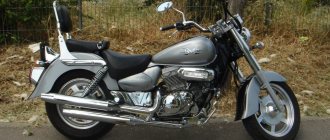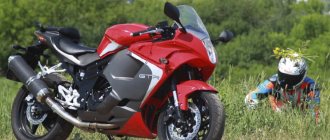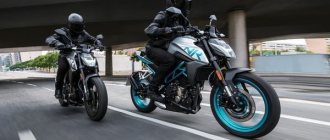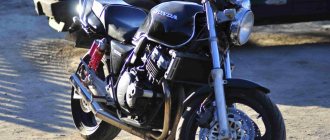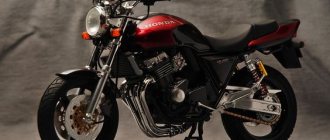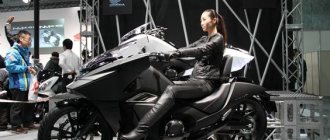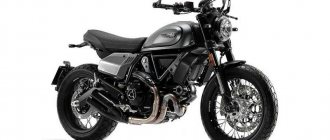Those. characteristics Hyosung Aquila GV250
This bike is more suitable for beginners. Today, the price of Hyusong Akila 250 in Russian showrooms is about 200,000 rubles, which is at least a third more expensive than its counterparts from China. It has a 250 cc fuel-injected V-twin engine with air-oil cooling that produces 24.9 hp. With. with a torque of 20 Nm and 7000 rpm.
Akila also has a standard 41 mm telescopic fork, chain drive and a five-speed gearbox. It is characterized by a classic appearance, which also distinguishes it from the Hyosung Aquila GV650, reviews of which even make comparisons with the Harley-Davidson V-Rod.
The bike has a casting behind which are the brakes: two discs at the front with primitive two-piston calipers, and one at the rear with a single-piston caliper. It is worth noting their effectiveness for a light motorcycle. The height of the Hyosung Aquile saddle is quite large - 710 mm. The gas tank volume is also large – 14 liters. It is enough for 300 km with a consumption of about 4 liters per 100 km. The dry weight of the device is 167 kg, dimensions: 2280x885x1095 mm.
Hyosung Aquila 250 is a standard model, differing from its Chinese counterparts only in price. For example, the Stealth Cruiser 400 is less expensive, although the characteristics are more powerful. The Akila's parameters are taken from the famous Yamaha Virago 400, which suggests that its design will bring fewer problems, including finding spare parts.
The quality of the Hyosung Aquila GV250 is very similar to the “purebred Chinese”, since on the Internet you can find quite a few unfavorable reviews and reviews after speed tests.
Characteristics of Hyosung Aquila GV650
The video of the Aquil 650I proves that it is quite an interesting model. Its first feature is its cost, which reaches 400-450 thousand rubles, which puts it on par with manufacturers from Japan and America. For example, today the Harley-Davidson Sportster 883 sells for half a million rubles in standard configuration.
Based on official data, the Hyosung Aquila 650 engine produces 72 hp at maximum speed. With. There is information that there were more modest measurements at the stand - only 60 liters. With. The same engine is installed on other 650 cc Husong models (sport and classic). That is, it is an average option, from which you should not expect power at the top in the sports class, or traction at the bottom, like in a chopper.
Among modern standards, the Hyosung Aquila 650 is distinguished by a high-quality braking system and an injection system. But there are many more shortcomings. In many Aquilas there are:
- curved seams, as in 125 models;
- low quality chrome and the same paint finish.
On the Internet you can find reviews from owners who rode their iron horse for more than one year, and during this time the steering wheel could fall apart while driving, or the brakes would jam. Of course, these are isolated cases, but they all speak against Aquilla. When faced with a choice between buying this motorcycle or buying an American or a representative of the “big Japanese four” for about the same price, it is unlikely that the buyer will pay attention to Husong. The only advantage is that in its configuration it looks complete, and you won’t need to spend money on a large number of accessories.
Test drive HyosungGT 650R
Watching the motorcycles that ride on the streets, every year you can increasingly see Hyosung motorcycles. Equipment under this Korean brand has been sold in Ukraine for only a couple of years, but in such a short period of time it has managed to gain sufficient popularity among both beginners and more or less experienced motorcyclists. The demand for products of this brand is caused, first of all, by a very good price-quality ratio: Hyosung motorcycles, with similar characteristics, are much cheaper than their Japanese counterparts. Their design is no worse, and in the case of the GV650 Aquila, even slightly better than its competitors. And at the same time, they have earned the reputation of being reliable and unpretentious devices.
We have already written about some Hyosung 250s. Now it’s the turn to step onto the next step - motorcycles with an engine capacity of 650 cm3. There are 4 such models in the Hyosung model range. The GV650 Aquila cruiser, the classic GT650 Comet, the GT650S – “street” with a semi-fairing and clip-ons instead of a steering wheel, as well as the sporty GT650R. The last three models have the same chassis. But the classic has a standard round headlight and two “wells” for a tachometer and a speedometer. And the GT650S, in turn, is a half-naked GT650R.
A little history.
Hyosung Motors and Machinery, Ltd. was founded in Korea in 1978 to produce motorcycles for the Asian market. A year later, Hyosung signed a cooperation and cooperation agreement with the Japanese company Suzuki Motors. Since then, Hyosung has manufactured and sold motorcycles under its own brand, as well as produced components and carried out partial or complete assembly of motorcycles for Suzuki. Hyosung later opened a division in Europe and began selling motorcycles with 125 and 250 cc engines, as well as scooters, in the European market. And only in 2004, Hyosung developed a 650 cc V-twin, on the basis of which the 4 above-mentioned motorcycles were created.
Due to the fact that only a few people know about the agreement between Hyosung and Suzuki, and also due to the lack of reliable information about all the intricacies of their cooperation, many buyers believe that the Hyosung GT650 series motorcycles are nothing more than a Korean copy of the Suzuki SV650 . But this is not true. The engine has been developed. It is true that both the GT650 and the SV650 have a two-cylinder V-twin with a 90-degree cylinder angle and similar geometry (piston stroke and cylinder diameter). But that's where their similarities end. The SV650 has 645 cubic meters of displacement and 70 hp. power (for models starting from 2003, equipped with an injector), and the GT650 has 647 cubic meters of volume and 79 hp. (for carburetor models 2004-2008). In addition, the design of the motors is significantly different, and this is noticeable even to the naked eye.
The frames of motorcycles are also different. The latest SV650 models feature a cast aluminum frame, while the GT650 features the original tubular frame. Even the old SV650 tubular frame was a completely different cut. So the Hyosung GT650 is not a copy. This is an original motorcycle that is nothing more than an ordinary competitor for the SV650.
But let's return to the subject of our test - the Hyosung GT650R. This bike, even in black, looks quite bright and aggressive. A full body kit, low clip-ons and a narrow silhouette - it seems that all the attributes of a sportbike are present. But this is only at first glance. 79 rated horsepower, when compared with modern 600 cc sportbikes, whose power reaches 130 hp, is not at all impressive. But the Hyosung GT650R is not positioned as a sportbike. I would call it more of a sport-tourist than a sportbike, and I think many will agree with me. To understand its true essence, walking around the city streets for an hour will not be enough. But I had two whole days left.
The first day. Run-in.
In my entire life I have only ridden one sportbike - a Yamaha R6. I remember him not only for his unbridled character, but also for his extremely uncomfortable fit. Therefore, looking at the sportbike look and low clip-ons of the GT650R, I frowned with displeasure at the thought that I would have to drive THIS for two whole days... But if it’s necessary, then it’s necessary! However, in reality everything turned out to be not so bad. Sitting behind the wheel of the GT650R did not at all remind me of the fetal position, and my legs, as if nothing had happened, immediately found a place on the low pegs. And only I had to lean towards the steering wheel, thereby shifting part of the load to my hands.
In the first minutes of interacting with the motorcycle, it seemed a little heavy to me (200 kg of dry weight is not a little, especially if you push it back and forth with your feet, taking the motorcycle out of the cabin). But when the motorcycle starts moving, this weight no longer seems so great. It should just be noted right away that starting off at idle (or close to it) speed is not very comfortable. It's better to give in a little. And in general, V-twins are characterized by some twitchiness at ultra-low speeds (close to idle), and this one is no exception. Although, if you get used to it and carefully release the clutch, “jerky” can be avoided. But! Having left the showroom in the morning, when most of the cars had not yet managed to take their owners to their place of work, I had to spend some time in the “toffee”. And in order to move on this motorcycle at a speed of 5-10 km/h, you have to constantly press the clutch so that the motorcycle does not jerk, but also does not pick up a higher speed. And since the clutch turned out to be quite tight, the left hand asked for mercy after just a few minutes of such a ragged rhythm of movement. And the right one, not accustomed to the loads inherent in a “sports” landing, also quickly got tired.
But halfway to work (read: respite) has already been passed, and it is impossible to stop. And the flow speed gradually began to increase, which means the frequency of using the clutch decreased. As for the arm-rest position: who said that a sports motorcycle should also be comfortable? In addition, for those who are too lazy to bend their backs, Hyosung has an excellent alternative, and for even less money - the GT650 Comet. He doesn't look that aggressive. But, to each his own!
A small “surprise” awaited me on the way. When the car driving in front of me began to approach sharply, I called on the brakes for help, but they were “not there.” At that moment, they, apparently, along with my soul, “went to their heels.” Fortunately, the reverse torque of the engine turned out to be sufficient to reduce the speed in time when switching to a lower gear. Hence the conclusion: for active riding on a completely new bike, do not be lazy to first let the brakes get used to it! I still had to do this all day, and therefore I will tell you more about the brakes in the second part of the test.
The GT650R, like many other "sporty" motorcycles, often requires the use of countersteering. I’ll say right away: for those who don’t know what it is and don’t know how to use it, it’s better not to choose the GT650R as their first motorcycle. The GT650R is very sensitive to crosswind gusts, and therefore, if you do not turn the steering wheel in time, the motorcycle can suddenly and strongly move to the side. It is also much easier to steer the bike into turns using countersteering. But for those who know how to do this, it will be easy to handle this bike, and they will receive extremely pleasant emotions from communicating with it. Likewise, I simply couldn’t get enough of the excellent handling of that motorcycle, which literally “understood” my commands and rode like it was on rails.
The torque of the GT650R engine is quite enough to quickly accelerate and to zip along the aisle between cars. In most cases, you don't need to downshift to quickly overtake. And if it is necessary, then only one, and not two, as would be the case on a 4-cylinder motorcycle. This “twin” pulls great, starting from 3.5 thousand rpm. If you “open” too much at lower speeds, transmission jerks will be felt. In other cases, the acceleration is smooth, but assertive - this “engine” does not have “pickup”, but there is confident traction, which starts from those same 3.5 thousand revolutions and ends only after 10 thousand.
The GT650R is characterized by a harsh gearbox operation, similar to the operation of a BMW motorcycle gearbox - some effort is required to be applied to the foot, and each shift is accompanied by a characteristic “grunt!” (audible, however, only at low speed, when the wind noise is still low). There can be no “under-switching” with such a box, but if little force is applied to the foot, there may be “under-shifting”. And then you have to press it again, with more force. But by the end of the first day I had trained myself and began to engage gears on the first try.
The pulsations of the engine were felt on the footrests and steering wheel, but they were so small that they did not cause any discomfort, and therefore I got to work with my arms a little tired from the unusual load, but in a great mood.
Honestly, I didn’t expect this inexpensive motorcycle to be so good. But, having examined the GT650R in more detail, I found in it several more additional “bonuses” that I had previously encountered only on motorcycles costing more than 10 thousand “conventional units”. For example, what are the standard driver's footrests, adjustable in four positions? No less useful is the ability to adjust the compression and rebound damping of the fork, although it does not have the ability to adjust the spring preload, which is somewhat strange. The rear shock absorber is connected to the swingarm via a linkage system, giving the rear suspension a progressive response. Among the settings - only adjusting the spring preload. As practice has shown, the standard suspension setting is the most optimal for our roads, both when driving in solo mode and with a passenger. The GT650R, despite its sporty appearance, was smooth enough to handle most small bumps as if they weren't there at all. And even when driving through more significant potholes, only gentle shocks were felt on the steering wheel and seat, which did not lead to discomfort. It seems that the energy capacity of pendants is simply limitless. Even in sharp turns on uneven asphalt, the motorcycle confidently stays on the intended trajectory. Therefore, in the “suspension performance” category, the GT650R receives a well-deserved 5 points.
An interesting feature I found was the ability to adjust the brightness of the digital instrument panel. Thanks to this, the readings are perfectly readable even in “high” sun, and at night it does not dazzle. The information content of the tidy is also excellent: all the necessary indicators are present, as well as a clock. The passenger seat is opened with a key. Below it is a small glove compartment, which, however, can easily accommodate a solid anti-theft chain with a lock. There is also a button to open the driver's seat. In the evening we managed to check the effectiveness of the headlight. One should not expect excellent results from headlights with lens optics, and this assumption was confirmed. Sometimes the area of the light beam was not enough, and therefore I didn’t want to go fast at all. I've met motorcycles that illuminated the road much more effectively. True, their headlights were not equipped with lenses, but with standard reflectors.
Second day. "Racing".
No, I didn't race anyone that day. I just had the opportunity to ride on the race track. But before that, I tested how comfortable it is to ride a motorcycle outside the city, and what the cruising speed would be. The motorcycle accelerates up to 130-140 km/h “in one breath” and you feel that it can also accelerate briskly further. But the low standard windshield limits the comfortable speed at this level. You can go faster, but only by clinging to the tank. And this will no longer be a very comfortable position. Due to the same headwind, your hands are a little unloaded at this speed and it’s easier to drive over fairly long distances. In addition, the soft seat provides the driver with a good level of comfort - in two days spent driving this motorcycle, out of habit, only my arms and neck were tired (since I had to lift my chin up all the time).
The passenger is much less fortunate - the seat area is very small, and the footrests are located as high as on real sportbikes. Comfortable handles for the passenger will ease the torment a little: one can hope that when braking, he will not lean his entire body on the driver. When driving with a passenger, maneuvering at low speeds was quite problematic. But due to the sagging of the rear suspension, it was easier to rest your feet on the ground.
The only good thing was that the loud sound of the engine helped me get through the traffic jams. Moreover, partly the muffler rumbled, and partly the intake sound was heard, as if a zero-resistance filter was installed on the motorcycle. This “bass singing” of the motor does not burden the ear and does not irritate. But how it helps! A couple of gasps and the drivers of cars in front notice you. If possible, move to the right or left and let them pass. But due to the narrow steering wheel, you can “sneak” into many cracks without “begging.”
A few words about orientation in the flow. The standard mirrors turned out to be not very practical. They clearly show what is going on in the lanes adjacent to the motorcycle, and therefore you can always change lanes without fear, guided solely by the mirrors. But due to the short distances, it was not possible to see what was happening behind me.
During the first day, the brakes managed to get used to, and therefore, when I got to the race track, I felt quite confident. But still, the first “sharp” braking turned out to be not so sharp. And this despite the fact that up to this point the motorcycle had already covered more than 140 km in the urban cycle with frequent braking. I expected a lot more performance from the 300mm front discs. That is, either the brakes have not yet completely gotten used to it, or they are actually weak. As for the information content, during the entire test I was left with the feeling of a certain “cottonness” of the brake lever. This is unacceptable for a sports motorcycle, but if you recognize the GT650R as a city motorcycle, then you can live with it. In addition, in the city this braking system was quite enough for me.
Otherwise the bike was docile and predictable on the track. If there is smooth asphalt under the wheels, you don’t have to be afraid to tilt the motorcycle too much and open full throttle when exiting corners. But it was difficult to move the motorcycle from side to side, due to its considerable weight, compared to sportbikes.
In general, as I said at the beginning of the article, the sportbike from this motorcycle is average. But it is very friendly, and therefore suitable for those who want a sports motorcycle, but who have little experience riding two-wheeled vehicles. The GT650R looks modern and is made of quite high quality: there are no complaints about the engine performance, suspension, or handling, and the price, which is at the level of similar “used” motorcycles from Japan, does not scare away the buyer. This, perhaps, lies the secret of the popularity of such motorcycles.
Text: Vladislav Sofonov
Photo: Andrey Shlenchak
The motorcycle was provided for testing.
